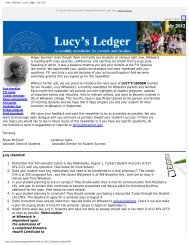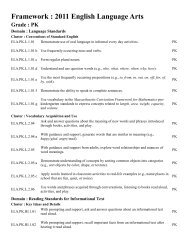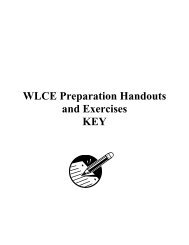Download the study (pdf)
Download the study (pdf)
Download the study (pdf)
Create successful ePaper yourself
Turn your PDF publications into a flip-book with our unique Google optimized e-Paper software.
The Organizational Impacts of Transition and Deployment in Military-Connected Schools:School-based Issues, Needs and ResponsesIn a recent report (RAND,2011), staff in military connected schools indicated <strong>the</strong>y had littleinformation on which students are military, when students may be experiencing deployment, and howmany students with military parents will be enrolling or leaving <strong>the</strong> school system at any given time.Our participants reported similar issues and described how <strong>the</strong>se issues create challenges to meeting <strong>the</strong>academic and social developmental needs of <strong>the</strong> military connected students <strong>the</strong>y serve.Record Keeping for Transitioning StudentsSchool administrators and administrative systems play a key role in determining <strong>the</strong> types ofservices students receive and in monitoring student academic and social emotional wellbeing throughout<strong>the</strong> year. In our <strong>study</strong>, <strong>the</strong> most consistently mentioned challenge at <strong>the</strong> organizational level for schoolswas related to transition. Specifically, participants spoke of <strong>the</strong> challenge of planning and providingtimely and appropriate services to transitioning students when <strong>the</strong>y had little advance or ongoinginformation about transitions. Principals often remarked that <strong>the</strong>y found it extremely difficult to predictenrollment, and thus provide optimal staffing. One principal recounted a story where early in <strong>the</strong> schoolyear <strong>the</strong> school reduced <strong>the</strong> number of teachers at a grade level because <strong>the</strong>re were not enough studentsto warrant ano<strong>the</strong>r class section. By October, each of <strong>the</strong> classes at that grade level was overenrolleddue to an influx of military connected students after <strong>the</strong> start of <strong>the</strong> school year. In ano<strong>the</strong>r case, acounselor described a situation of having many more children at a grade level than expected, whereby<strong>the</strong> district was forced to hire ano<strong>the</strong>r teacher and split <strong>the</strong> class. Children, including military connectedchildren, were in <strong>the</strong> position of <strong>the</strong> having begun <strong>the</strong> year with one teacher and <strong>the</strong>n had to switch toano<strong>the</strong>r. The potential social-emotional impact of this event on <strong>the</strong>se young students is evident in <strong>the</strong>counselor’s remarks, “Dad has been gone and <strong>the</strong>n we move <strong>the</strong>m to ano<strong>the</strong>r teacher. How terrible isthat?” It is also reasonable to imagine that such disruptions to <strong>the</strong> routine of instruction would likelyhave academic impacts, for all students in <strong>the</strong>se classes. In a context where schools are attempting tomitigate <strong>the</strong> effects of transition on students by providing <strong>the</strong>m with stability in <strong>the</strong> school experience,participants noted it would be beneficial to have advance information about transitioning students for <strong>the</strong>purposes of planning, <strong>the</strong> provision of timely and appropriate services and placements, <strong>the</strong> ability tomaintain reasonable and stable class sizes in which all children’s social and emotional and academicneeds can be optimally met, and <strong>the</strong> capacity to minimize last minute scheduling and classroom changesthat are disruptive to learning.The Need for Data Systems to Support Programming for Military StudentsIn order for schools to anticipate, monitor and effectively resource programs for militarystudents, <strong>the</strong>re is a critical need to implement systems to track <strong>the</strong> numbers of military children served in<strong>the</strong> district and school. But we did not hear evidence in any of <strong>the</strong> schools that formal, school-widesystems were in place. Data and record keeping on military connected students as a specific populationwas also reported to be challenging in many of <strong>the</strong> schools in our <strong>study</strong>. Most of <strong>the</strong> participantsreported a reliance on informal mechanisms for finding out which students in <strong>the</strong>ir schools were militaryconnected students. The most frequent approach was to find out from <strong>the</strong> parents at <strong>the</strong> school levelwhen <strong>the</strong> parent registered <strong>the</strong>ir child for school. Many schools reported asking or finding out from <strong>the</strong>students <strong>the</strong>mselves. Some participants reported not knowing at all—one counselor remarked, “Unless aperson in a military uniform walks in, you don’t know.” Schools that collect data for Impact Aid weremore likely to have some of this information, but one participant reported that <strong>the</strong>se data are collected17
















